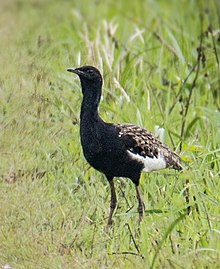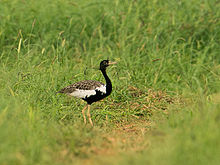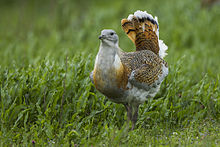This article contains a list that has not been properly sorted. See
MOS:LISTSORT for more information. (March 2023) |
This is a list of Otidiformes species by global population. While numbers are estimates, they have been made by the experts in their fields. For more information on how these estimates were ascertained, see Wikipedia's articles on population biology and population ecology. This list is not comprehensive, as not all species have had their global populations estimated.
Species by global population
| Common name | Binomial name | Population | Status | Trend | Notes | Image |
|---|---|---|---|---|---|---|
| Great Indian bustard | Ardeotis nigriceps | 300 [1] | CR [1] | Maximum estimate. Equal to 250 mature individuals. [1] |

| |
| Bengal florican | Houbaropsis bengalensis | 350-1,500 [2] | CR [2] | Equal to 250-999 mature individuals. [2] |

| |
| Lesser florican | Sypheotides indicus | 730 [3] | CR [3] | Estimate for mature individuals only. Wider estimate is 356–1,228 mature individuals. [3] |

| |
| Blue bustard | Eupodotis caerulescens | 12,000-15,000 [4] | NT [4] | Equal to 8,000-10,000 mature individuals. [4] |

| |
| African houbara | Chlamydotis undulata | 20,000-49,999 [5] | VU [5] | Equal to 13,000-33,000 mature individuals. [5] |

| |
| Great bustard | Otis tarda | 44,000-57,000 [6] | VU [6] |

| ||
| Asian houbara | Chlamydotis macqueenii | 50,000-99,999 [7] | VU [7] | Equal to 33,000-67,000 mature individuals. Global population estimates are difficult to establish for this species. [7] |

| |
| Australian bustard | Ardeotis australis | 100,000 [8] | LC [8] | Maximum estimate. Roughly equal to 6,700-67,000 mature individuals. [8] |

| |
| Little bustard | Tetrax tetrax | 100,000-499,999 [9] | NT [9] | European subpopulation estimated at 122,000-240,000 mature individuals. [9] |

| |
| Ludwig's bustard | Neotis ludwigii | 100,000-499,999 [10] | EN [10] | Estimate may be too wide. Further work to refine it is underway in Namibia. [10] |

|
References
- ^
a
b
c
d IUCN (2018-08-17).
"Ardeotis nigriceps: BirdLife International: The IUCN Red List of Threatened Species 2018: e.T22691932A134188105".
doi:
10.2305/iucn.uk.2018-2.rlts.t22691932a134188105.en.
{{ cite journal}}: Cite journal requires|journal=( help) - ^
a
b
c
d IUCN (2018-08-07).
"Houbaropsis bengalensis: BirdLife International: The IUCN Red List of Threatened Species 2018: e.T22692015A130184896".
doi:
10.2305/iucn.uk.2018-2.rlts.t22692015a130184896.en.
{{ cite journal}}: Cite journal requires|journal=( help) - ^
a
b
c
d IUCN (2021-08-12).
"Sypheotides indicus: BirdLife International: The IUCN Red List of Threatened Species 2021: e.T22692024A199959007".
doi:
10.2305/iucn.uk.2021-3.rlts.t22692024a199959007.en.
{{ cite journal}}: Cite journal requires|journal=( help) - ^ a b c d "Eupodotis caerulescens: BirdLife International". IUCN Red List of Threatened Species. 2017-10-01. Retrieved 2023-03-17.
- ^
a
b
c
d IUCN (2016-10-01).
"Chlamydotis undulata: BirdLife International: The IUCN Red List of Threatened Species 2016: e.T22728245A90341807".
doi:
10.2305/iucn.uk.2016-3.rlts.t22728245a90341807.en.
{{ cite journal}}: Cite journal requires|journal=( help) - ^
a
b
c IUCN (2017-10-01).
"Otis tarda: BirdLife International: The IUCN Red List of Threatened Species 2017: e.T22691900A119044104".
doi:
10.2305/iucn.uk.2017-3.rlts.t22691900a119044104.en.
{{ cite journal}}: Cite journal requires|journal=( help) - ^
a
b
c
d IUCN (2021-08-18).
"Chlamydotis macqueenii: BirdLife International: The IUCN Red List of Threatened Species 2021: e.T22733562A205364424".
doi:
10.2305/iucn.uk.2021-3.rlts.t22733562a205364424.en.
{{ cite journal}}: Cite journal requires|journal=( help) - ^
a
b
c
d IUCN (2016-10-01).
"Ardeotis australis: BirdLife International: The IUCN Red List of Threatened Species 2016: e.T22691940A93330335".
doi:
10.2305/iucn.uk.2016-3.rlts.t22691940a93330335.en.
{{ cite journal}}: Cite journal requires|journal=( help) - ^
a
b
c
d IUCN (2018-08-07).
"Tetrax tetrax: BirdLife International: The IUCN Red List of Threatened Species 2018: e.T22691896A129913710".
doi:
10.2305/iucn.uk.2018-2.rlts.t22691896a129913710.en.
{{ cite journal}}: Cite journal requires|journal=( help) - ^
a
b
c
d IUCN (2016-10-01).
"Neotis ludwigii: BirdLife International: The IUCN Red List of Threatened Species 2018: e.T22691910A129456278".
doi:
10.2305/iucn.uk.2016-3.rlts.t22691910a129456278.en.
{{ cite journal}}: Cite journal requires|journal=( help)